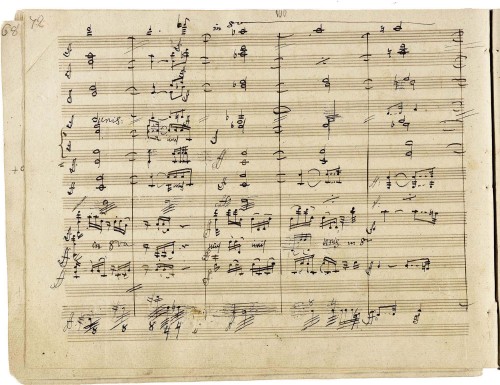Progressive deafness profoundly influenced Beethoven's compositions, prompting him to choose lower-frequency notes as his condition worsened, scientists said on Tuesday.

Beethoven first mentioned his hearing loss in 1801 at the age of 30, complaining that he was having problems hearing the high notes of instruments and voices.
By 1812, people had to shout to make themselves understood and in 1818, he started to communicate through notebooks. In his last few years before his death in 1827, his deafness was apparently total.
Writing in the latest issue of the British Medical Journal (BMJ), a trio of scientists in the Netherlands dissected Beethoven's string quartets.
They grouped these works into four ages, ranging from early (1798-1800) to late (1824-26).
The experts looked at the first violin part in the first movement of each quartet, counting the number of notes above G6, which corresponds to 1,568 Hertz.
Use of higher notes decreased as the deafness progressed, they found.
To compensate, Beethoven used more middle- and low-frequency notes, which he could hear better when music was performed.
But in the late quartets -- written by the time he was totally deaf -- the higher notes returned.
"When he came to rely completely on his inner ear, he was no longer compelled to produce music he could actually hear when performed, and slowly returned to his inner musical world and early composing experiences," says the paper.
The study is authored by Edoardo Saccenti, Age Smilde and Wim Saris of the Netherlands Metabolomics Centre in Leiden.
A video of the research can be seen on (http://www.youtube.com/watch?v=dLYhIwT5A5c&feature=youtu.be).
(AFP)
<한글 기사>
베토벤의 난청과 작곡 패턴의 상관성 밝혀졌다
난청이 베토벤의 작곡스타일에 변화를 가져왔다는 연구결과가 나왔다.
네덜란드 대사체분석센터(Metabolomics Center)의 에도아르도 사센티(Edoardo Saccenti) 등 3인 연구팀은 베토벤이 30세 때인 1801년부터 점차 청력을 잃어가면서 청력변화에 따라 작곡스타일도 변해갔다고 밝혔다.
베토벤은 1801년 난청이 진행되면서 1812년에는 다른 사람들이 소리를 질러야 알아들을 수 있을 정도로 악화되었고 1818년에는 쪽지에 글을 써서 대화하기 시작했다. 1827년엔 청력이 완전 소실된 것으로 알려지고 있다.
연구팀은 베토벤의 작곡시기를 1798-1800년에서 1824-1826년까지 4기로 나누어 각각의 기간에 작곡된 현악4중주들의 악보 중 1악장 제1바이올린 파트에서 가청주파수가 1천568헤르츠에 해당하는 G6음보다 높은 음표가 몇개인지를 세어보았다.
그 결과 난청이 악화되면서 G6음보다 높은 음표의 사용이 점점 줄어들고 연주될 때 보다 잘 들리는 중간과 낮은 주파수에 해당하는 음표의 사용이 늘어난 것으로 나 타났다.
청력이 완전히 소실될 즈음인 말기에 작곡된 현악4중주에서는 고주파에 해당하는 음표들이 다시 나타났다.
완전히 들리지 않아 머리 속에서만 들리는 음에만 의존하게 되었을 때는 작곡패턴이 초기의 작곡스타일로 되돌아 간 것으로 나타났다.
이 연구결과는 영국 의학저널(British Medical Journal) 최신호에 발표되었다.







![[KH Explains] How should Korea adjust its trade defenses against Chinese EVs?](http://res.heraldm.com/phpwas/restmb_idxmake.php?idx=644&simg=/content/image/2024/04/15/20240415050562_0.jpg&u=20240415144419)










![[Today’s K-pop] Stray Kids to return soon: report](http://res.heraldm.com/phpwas/restmb_idxmake.php?idx=642&simg=/content/image/2024/04/16/20240416050713_0.jpg&u=)